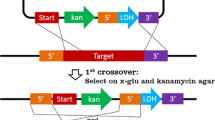Abstract
A collection of polyauxotrophic mutants of the obligate methylotroph Methylobacillus flagellatum KT was obtained. On the first step two stable auxotrophic mutants with a high requirement for amino acids supplements were isolated by treatment with nitrosoguanidine and selection on complete medium. Spontaneous variants of these mutants with a low requirement for nutrient supplements were the base for obtaining polyauxotrophic strains. It was shown, that the growth of mutants of M. flagellatum KT is inhibited by complete medium. Some amino acids and nucleotides are the inhibitor components of complete media. An approach for selection of auxotrophic mutants of individual genes was worked out on minimal medium. The optimal conditions for nitrosoguanidine mutagenesis of M. flagellatum KT were developed. The possible mechanisms of action of some of the nutrient supplements on the growth of M. flagellatum KT are discussed.
Similar content being viewed by others
References
Adelberg EA, Mandell M, Chen CC (1965) Optimal conditions for mutagenesis by N-methyl-N′-nitro-N-nitrosoguanidine in Escherichia coli K-12. Biochem Biophys Res Commun 18:788–795
Bachmann BJ (1983) Linkage map of Escherichia coli K-12, edition 7. Microbiol Rev 47:180–230
Camarakis J, Pittard J (1971) Repression of 3-deoxy-D-arabinoheptulosonic acid-7-phosphate synthetase (trp) and enzymes of the tryptophan pathway in Escherichia coli K-12. J Bacteriol 107:406–414
Cielsa A, Salvatore F, Broach JR, Artz SW, Ames BN (1975) Histidine regulation in Salmonella typhimurium. XVI. A sensitive radiochemical assay for histidinol dehydrogenase. Anal Biochem 63:44–55
Colby J, Zatman LJ (1975) Tricarboxylic acid-cycle and related enzymes in restricted facultative methylotrophs. Biochemical J 148:501–511
Crawford IP (1975) Gene rearrangements in the evolution of tryptophan synthetic pathway. Bacteriol Rev 39:87–120
Eccleston M, Kelly DP (1972) Competition among amino acids for incorporation into Methylococcus capsulatus. J Gen Microbiol 73:303–314
Eccleston M, Kelly DP (1973) Inhibition by l-threonine of aspartokinase as a cause of threonine toxicity to Methylococcus. J Gen Microbiol 75: 223–226
Ely B (1974) Physiological studies of Salmonella histidine operator-promoter mutants. Genetics 78:593–606
Fiske MJ, Whitaker RJ, Jensen RA (1983) Hidden overflow pathway to l-phenylalanine in Pseudomonas aeruginosa. J Bacteriol 154:623–631
Garrick-Silversmith L, Hartman PE (1970) Histidine-requiring mutants of Escherichia coli K-12. Genetics 66:231–244
Gliesche CG, Hirsch P (1986) Mutagenesis in Hyphomicrobium sp. B-522. In: Duine JA, Verseveld HW van (eds) Abstract of the 5th International Symposium on Microbial Growth on C1 Compounds, p 156
Goldschmidt EP, Cater MS, Matney TS, Butler MA, Green A (1970) Genetic analysis of the histidine operon in Escherichia coli K-12. Genetics 66:219–229
Govorukhina NI, Kletsova LV, Tsygankov YD, Trotsenko YA, Netrusov AI (1987) Characteristics of a new obligate methylotrophous bacterium. Mikrobiologiya (USSR) 56:849–854
Haber CL, Allen LN, Zhao S, Hanson RS (1983) Methylotrophic bacteria: biochemical diversity and genetics. Science 221: 1147–1153
Higgins IJ, Best DJ, Hammond RC, Scott D (1981) Methane-oxidizing microorganisms. Microbiol Rev 45:556–590
Holliday R (1956) A new method for the identification of biochemical mutants of microorganisms. Nature (Lond) 178:987–990
Holloway BW, Morgan AF (1986) Genome organization in Pseudomonas. Ann Rev Microbiol 40:79–105
Im SWK, Pittard J (1971) Phenylalanine biosynthesis in Escherichia coli K-12: mutants derepressed for chorismate mutase p-prephenate dehydratase. J Bacteriol 106:784–790
Lowry OH, Rosebrough NJ, Farr AL, Randall RJ (1951) Protein measurement with the Folin phenol reagent. J Biol Chem 193:265–275
Maniatis T, Fritsch EF, Sambrook J (1982) Molecular cloning. A laboratory manual. Cold Spring Harbor Laboratory, Cold Spring Harbor, New York
Miller JH (1972) Experiments in molecular genetics. Cold Spring Harbor Laboratory, Cold Spring Harbor, New York, pp 431–433
O'Connor ML, Wopat A, Hanson RS (1977) Genetic transformation in Methylobacterium organophilum. J Gen Microbiol 98:265–272
O'Connor ML, Hanson RS (1978) Linkage relationships between mutants of Methylobacterium organophilum impaired in their ability to grow on one-carbon compounds. J Gen Microbiol 104:105–111
Pinchuk GE (1986) The regulation of aspartat family amino acids biosynthesis in methane-oxidizing bacterium Methylococcus thermophilus. In: Duine JA, Verseveld HW van (eds) Abstracts of the 5th International Symposium on Microbial Growth on C1 Compounds, p 174
Sklar R (1978) Enhancement of nitrosoguanidine mutagenesis by chloramphenicol in Escherichia coli K-12. J Bacteriol 136:460–462
Tatra PK, Goodwin PM (1983) R-plasmid mediated chromosome mobilization in the faculative methylotroph Pseudomonas AM1. J Gen Microbiol 129:2629–2632
Trotsenko YA (1976) Isolation and characterisation of obligate methanotrophic bacteria. In: Schlegel HG, Gottschalk G, Pfennig N (eds) Symposium of gases (H2, CH4,CO). Akademic der Wissenschaften, Göttingen, pp 329–336
Vries GE de (1986) Molecular biology of bacterial methanol oxidation. FEMS Microbiol Rev 39:235–258
Whitta S, Sinclair MI, Holloway BW (1985) Transposon mutagenesis in Methylobacterium AM1 (Pseudomonas AM1). J Gen Microbiol 131:1547–1549
Whittenbury R, Phillips KC, Wilkinson JF (1970) Enrichment, isolation and some properties of methane-utilising bacteria. J Gen Microbiol 61:205–218
Williams E, Shimmin MA (1978) Radiation-induced filamentation in obligate methylotrophs. FEMS Microbiol Lett 4:137–141
Windass JD, Worsey MJ, Pioli EM, Pioli D, Barth PT, Atherton KT, Dart EC, Byrom D, Powell K, Senior PJ (1980) Improved conversion of methanol to single cell protein by Methylophilus methylotrophus. Nature (Lond) 287:396–401
Zhao S-J, Hanson RS (1984) Isolate 761M: a new type 1 methanotroph that possesses a complete tricarboxylic acid cycle. Appl Environm Microbiol 48:1237–1242
Author information
Authors and Affiliations
Rights and permissions
About this article
Cite this article
Tsygankov, Y.D., Kazakova, S.M. Development of gene transfer systems in Methylobacillus flagellatum KT: Isolation of auxotrophic mutants. Arch. Microbiol. 149, 112–119 (1987). https://doi.org/10.1007/BF00425075
Received:
Accepted:
Issue Date:
DOI: https://doi.org/10.1007/BF00425075




